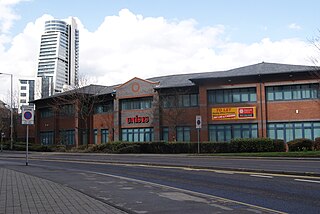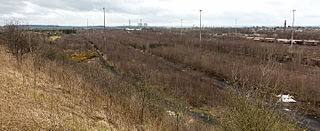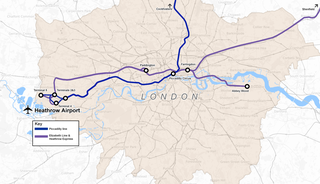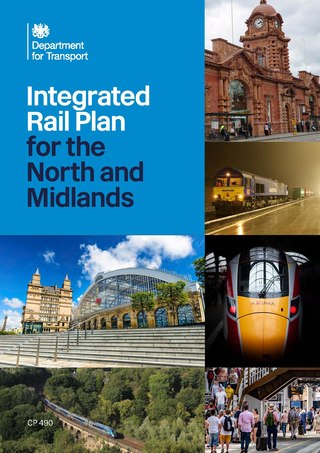
Regional Eurostar was a planned Eurostar train service from Paris and Brussels to locations in the United Kingdom to the north and west of London.

High-speed rail in the United Kingdom is provided on five upgraded railway lines running at top speeds of 125 mph (200 km/h) and one purpose-built high-speed line reaching 186 mph (300 km/h).

Old Oak Common (OOC) is a railway station under construction on the site of the Old Oak Common traction maintenance depot to the west of London in Old Oak Common, approximately 500 m (1,600 ft) south of Willesden Junction station. When built, it is expected to be one of the largest rail hubs in London, at about 800 m (2,600 ft) in length and 20 m (66 ft) below surface level.

High Speed 2 (HS2) is a planned high-speed railway line and network of passenger train services in Great Britain. The new railway line, which is currently under construction in England, is to run between the West Midlands and London, with a spur to Birmingham. A network of train services will use the new line and existing conventional track to reach their destinations in the Midlands, North West England, and Scotland. HS2 is to be Britain's second purpose-built high-speed line after High Speed 1, which connects London to the Channel Tunnel. The majority of the project is planned to be completed between 2029 and 2033.
Heathrow Hub railway station was a proposed interchange that would serve – mainly – a now disbanded potential alignment of High Speed 2 (HS2) services that would adjoin the expanded part of Heathrow Airport, England. It was a cornerstone part of an expansion plan put forward in 2008, by engineering firm Arup, to set up the UK's first high-speed rail network north-west of London.

The West London Orbital is a proposed extension to the London Overground railway system. The extension would make use of a combination of existing freight and passenger lines including the Dudding Hill Line, North London Line and Hounslow Loop. The route would run for approximately 11 miles (17 km) from West Hampstead and Hendon at the northern end to Hounslow at the western end via Brent Cross West, Neasden, Harlesden, Old Oak Common, South Acton and Brentford.

The Northern Hub was a rail upgrade programme between 2009 and 2020 in Northern England to improve and increase train services and reduce journey times between its major cities and towns, by electrifying lines and removing a major rail bottleneck in Manchester. It was predicted to stimulate economic growth in the region. The project had several elements but the prime objective was to eradicate the bottleneck in Manchester and allow trains to travel through the city at speed without stopping. The project was announced as the Manchester Hub in 2009. The project's steering partnership involved Network Rail, Deutsche Bahn, First TransPennine Express, Northern Rail, East Midlands Trains, CrossCountry, Freightliner, the Department for Transport, Transport for Greater Manchester and Merseytravel.

Leeds New Lane was a proposed new railway station to accommodate High Speed Two rail services in West Yorkshire, England. It was planned to be constructed on a viaduct on New Lane south of Leeds city centre, the River Aire and Leeds City station to which it would be connected by an elevated walkway. The site is occupied by Central Park, a small low-rise office park built in the 1990s and other small office buildings.

East Midlands Hub was a planned new railway station on the Leeds Branch of High Speed 2. It was intended to be located on the existing railway sidings in Toton, situated between Nottingham and Derby. The station would have been located adjacent to the M1 motorway in Nottinghamshire, on the border with Derbyshire.

High Speed 2 is a planned new high-speed railway line connecting London with the city centres of Birmingham, Manchester and Leeds directly on new high speed track. East Midlands Airport will also be served. The railway is to be delivered in two phases:

Manchester Airport High Speed Station was a planned High Speed 2 station at Manchester Airport, on the southern boundary of Manchester, England, next to Junction 5 of the M56 motorway on the northern side of the airport 1.5 miles (2.4 km) north-west of Manchester Airport railway station.

Northern Powerhouse Rail (NPR), sometimes referred to unofficially as High Speed 3, is a proposed major rail programme designed to substantially enhance the economic potential of the North of England. The phrase was adopted in 2014 for a project featuring new and significantly upgraded railway lines in the region. The aim is to transform rail services between the major towns and cities, requiring the region's single biggest transport investment since the Industrial Revolution. The original scheme would have seen a new high-speed rail line from Liverpool to Warrington continuing to join the HS2 tunnel which it would share into Manchester Piccadilly station. From there, the line would have continued to Leeds with a stop at Bradford. The line was intended to improve journey times and frequency between major Northern cities as well as creating more capacity for local service on lines that express services would have been moved out from.

Transport for the North (TfN) is the first statutory sub-national transport body in the United Kingdom. It was formed in 2018 to make the case for strategic transport improvements across the North of England. Creating this body represented an unprecedented devolution of power from central government. TfN brings together the North's twenty local transport authorities and business leaders together with Network Rail, National Highways, and HS2 and works with the UK Government. The organisation has offices in Manchester and Leeds.

The history of High Speed 2 is the background to the planned construction of High Speed 2 (HS2), a new high-speed railway in Great Britain that would connect London, Birmingham, Manchester, Leeds and other cities in the UK.

HS4Air is a proposal for a 140-kilometre (87 mi) high-speed railway line in the United Kingdom, put forward in 2018 by a British engineering consultancy, Expedition Engineering.

Over the years, a number of transport proposals have been made to improve public access to Heathrow Airport, near London in the United Kingdom.

The Integrated Rail Plan for the North and Midlands or more simply, the Integrated Rail Plan (IRP), is a United Kingdom government proposal published on 18 November 2021. It aims to deliver "increased capacity, faster journeys or more frequent services on eight out of the top ten busiest rail corridors across the North and Midlands", by developing rail services along with the required infrastructure in these regions of England. It was published by the Department for Transport (DfT) and features forewords by Prime Minister Boris Johnson and Transport Secretary Grant Shapps, but its publication was delayed a number of times, partly because of the COVID-19 pandemic. It contains the significant proviso that "In line with the Government's existing approach to rail enhancements, commitments will be made only to progress individual schemes up to the next stage of development, subject to a review of their readiness." A Technical Annexe was published in January 2022. A correction slip was issued March 2022.

East West Rail is a strategic aim to establish a new main line railway between East Anglia and South Wales. The immediate plan is to build a line linking Oxford and Cambridge via Bicester, Milton Keynes and Bedford, largely using the trackbed of the former Varsity Line. Thus it provides a route between any or all of the Great Western, Chiltern, West Coast, Midland, East Coast, West Anglia, Great Eastern and the Cotswold main lines, avoiding London. The new line will provide a route for potential new services between Southampton Central or Swansea and Ipswich or Norwich via Reading, Didcot and Ely, using existing onward lines. The government approved the western section in November 2011, with completion of this section expected by 2025.
















